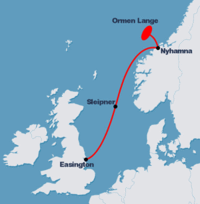
Photo from wikipedia
Abstract It is common for subsea pipelines to operate at high pressures and high temperatures (HPHT) conditions. The build-up of axial force along the pipeline due to temperature and pressure… Click to show full abstract
Abstract It is common for subsea pipelines to operate at high pressures and high temperatures (HPHT) conditions. The build-up of axial force along the pipeline due to temperature and pressure differences from as-laid conditions coupled with the influence of the seabed soil that restricts free movement of the pipeline can result in the phenomenon called ‘lateral buckling’. The excessive lateral deformation from lateral buckling may risk safe operation of the pipeline due to local axial strains that potentially could be severe enough to cause fracture failure of welds or collapse of the pipeline. Engineered buckles may be initiated reliably during operation by using special subsea structures or lay methods which are expensive. This paper introduces and exemplifies a novel method that involves continuously deforming the pipeline prior to or during installation with prescribed radius and wavelength to control lateral buckling that could be a valuable modification of the practical design of offshore pipelines. Previous published work has shown that installation of a pipeline with such continuous deformations is feasible. The results from an example pipeline case described here show that the pipeline can be installed and operated safely at elevated temperatures without the need for other expensive buckle initiation methods.
Journal Title: Ocean Engineering
Year Published: 2018
Link to full text (if available)
Share on Social Media: Sign Up to like & get
recommendations!